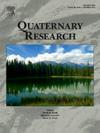Changes in the lake-grassland ecosystem revealed by multiple proxies in a sediment core from Ganggeng Nur Lake, northern China
IF 1.8
3区 地球科学
Q3 GEOGRAPHY, PHYSICAL
引用次数: 0
Abstract
As the main global terrestrial ecosystem component, grasslands are extremely sensitive to global climate change. With increasing human activities over the last century, grassland ecosystems have been degraded to different degrees. However, the evolution of lake-grassland ecosystems in recent centuries remains unclear due to the dearth of high-resolution records. Here, we present high-resolution lacustrine sediment grain size, pollen (Artemisia, Myriophyllum), Pediastrum, and n-alkane records from Ganggeng Nur Lake to investigate vegetation, lake evolution, and human effects in semiarid northern China. Four stages were identified from the last ca. 150 years: (1) the natural evolution stage (AD 1870–1945), in which there was a wet climate around Ganggeng Nur and the lake level rose from increased runoff; (2) the human disturbance stage (AD 1945–1967), in which the regional climate got drier and human activities began having a detectable effect on the grassland ecosystem; (3) the human transformation stage (AD 1967–2005), in which a completely arid climate coupled with the implementation of a series of land reclamation policies resulted in a large reduction in grassland areas, extensive soil erosion, exacerbated climate change, and shrinking lake areas; and (4) the posttreatment stage (AD 2005–2018), in which soil erosion was alleviated by policy implementation and a favorable humid climate.从中国北方冈庚湖沉积物核心的多个指标揭示湖泊草原生态系统的变化
草原作为全球陆地生态系统的主要组成部分,对全球气候变化极为敏感。上个世纪以来,随着人类活动的增加,草原生态系统出现了不同程度的退化。然而,由于缺乏高分辨率的记录,近几个世纪湖泊草原生态系统的演变仍不清楚。在这里,我们提供了来自岗更诺尔湖的高分辨率湖泊沉积物粒度、花粉(蒿属、Myriophyllum)、Pediastum和正构烷烃记录,以调查中国北方半干旱地区的植被、湖泊演变和人类影响。从上一个约150年开始,共确定了四个阶段:(1)自然进化阶段(公元1870-1945年),在该阶段,岗更努尔周围气候潮湿,湖泊水位因径流增加而上升;(2) 人类干扰阶段(公元1945–1967年),区域气候变得更干燥,人类活动开始对草原生态系统产生可检测的影响;(3) 人类转型阶段(公元1967–2005年),完全干旱的气候加上一系列土地开垦政策的实施,导致草原面积大幅减少,土壤侵蚀广泛,气候变化加剧,湖泊面积缩小;以及(4)后处理阶段(公元2005-2018年),在该阶段,政策实施和有利的湿润气候缓解了土壤侵蚀。
本文章由计算机程序翻译,如有差异,请以英文原文为准。
求助全文
约1分钟内获得全文
求助全文
来源期刊

Quaternary Research
地学-地球科学综合
CiteScore
4.70
自引率
8.70%
发文量
57
审稿时长
3 months
期刊介绍:
Quaternary Research is an international journal devoted to the advancement of the interdisciplinary understanding of the Quaternary Period. We aim to publish articles of broad interest with relevance to more than one discipline, and that constitute a significant new contribution to Quaternary science. The journal’s scope is global, building on its nearly 50-year history in advancing the understanding of earth and human history through interdisciplinary study of the last 2.6 million years.
 求助内容:
求助内容: 应助结果提醒方式:
应助结果提醒方式:


